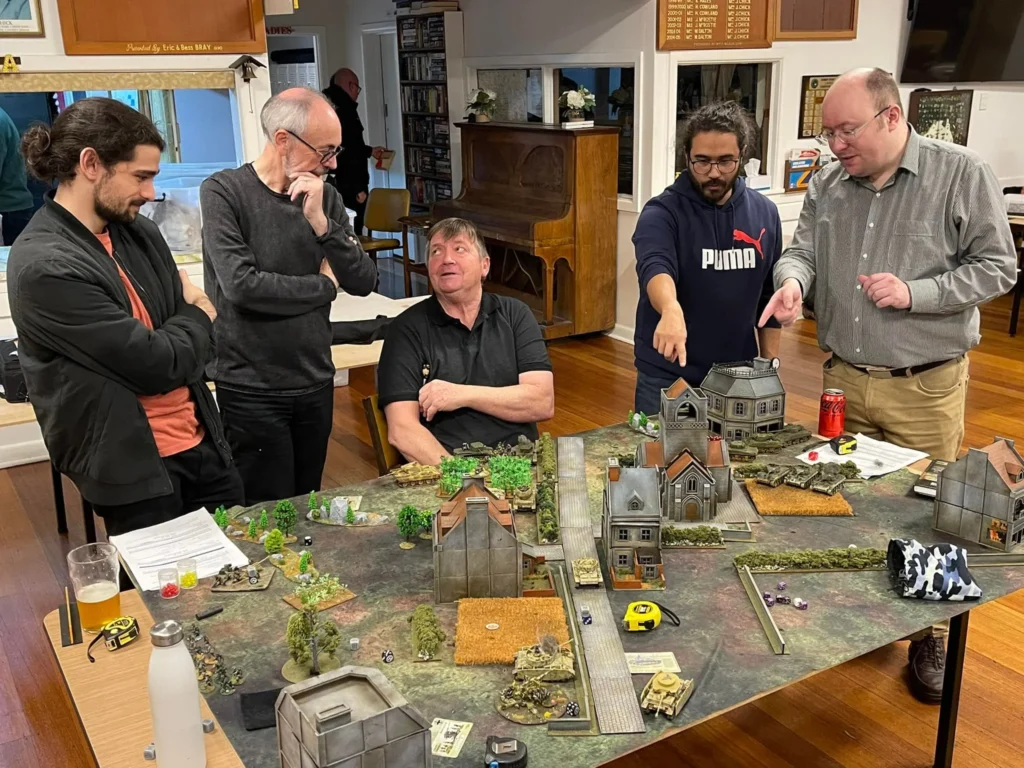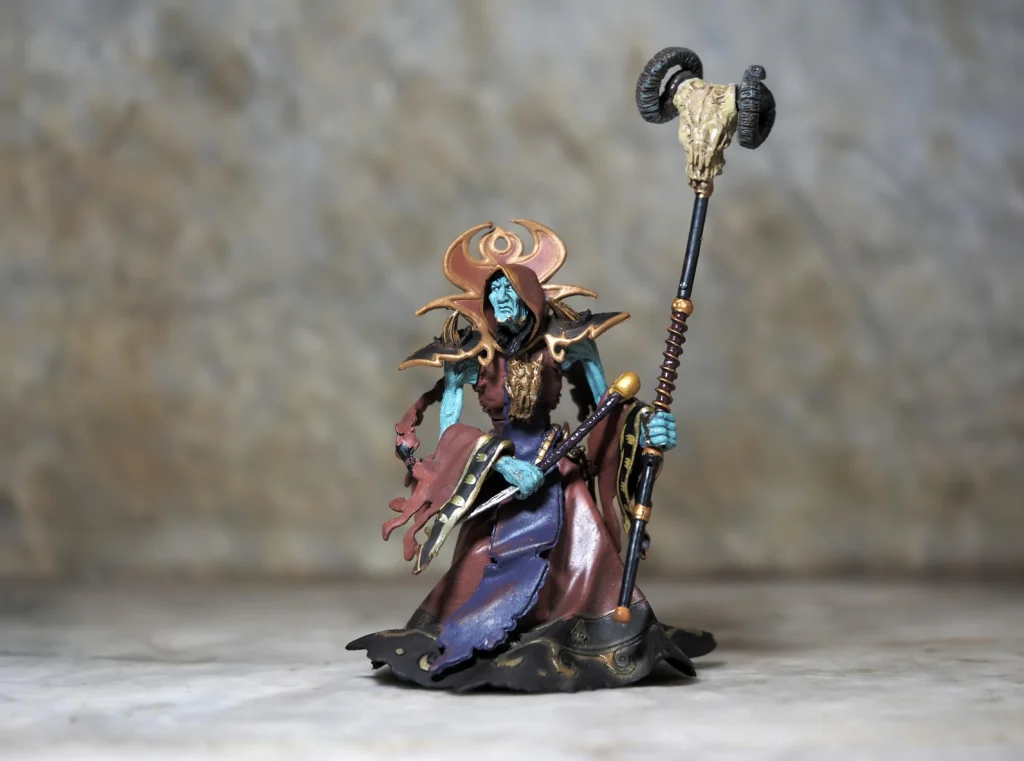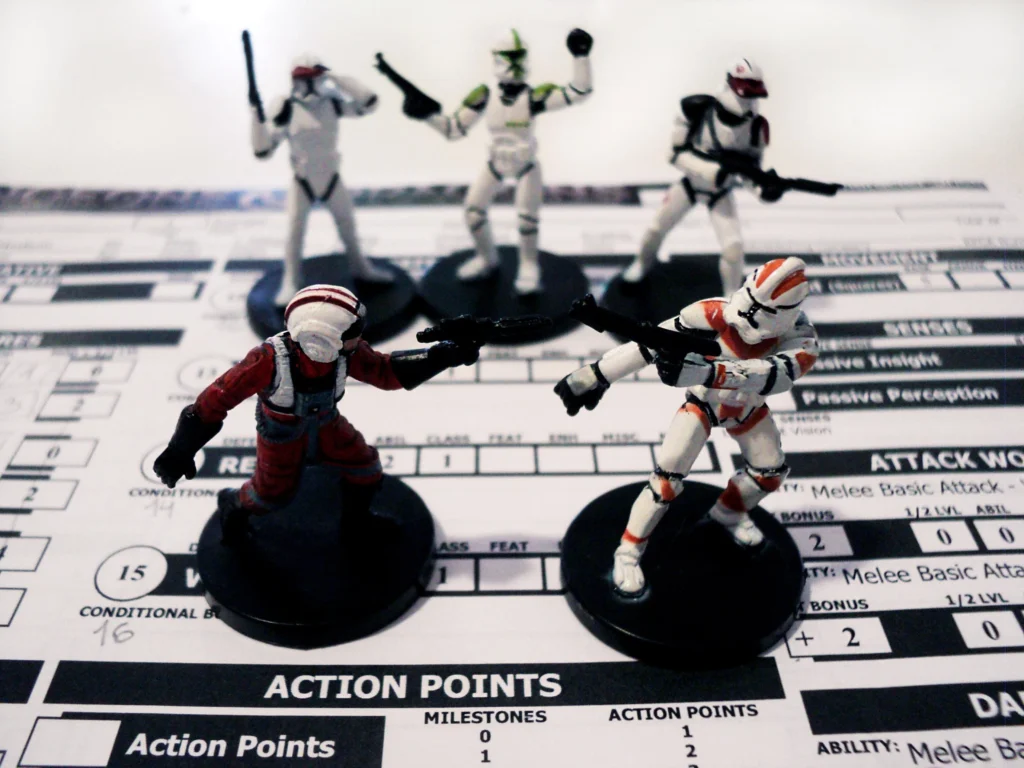And Why You Might Want to As Well
I’m in my early 60’s. As a kid I started wargaming and actively continued it through to my mid 20’s, at which point gaming on the computer took over. But a few months ago I returned to wargaming. In this article, I will explore why and also why you might want to consider this hobby.

The author is second from the left, holding his chin. A WWII game using the Bolt Action rules.
What is Wargaming?
In the broadest sense, wargaming is a form of game where war or military conflict is the main focus. We will define a wargame as an attempt to create a fairly realistic game that, when using real opposing forces will tend to produce outcomes that are consistent with what might happen in reality or, in the case of refighting historical situations, tend to produce historically valid outcomes. There are two very different types of wargaming — professional and hobby.
The military establishment wargame actively, and in fact invented wargaming, as a way to both train and also to explore aspects of strategy and tactics in a developmental, experimental way. The Prussians developed wargaming in the sense I’ve defined above in the late 18th and early 19th Centuries. For an article about one aspect of professional wargaming today, have a read of this.
Hobby wargaming evolved out of toy soldiers and really emerged when H.G. Wells published a set of wargaming rules using miniature soldiers in 1913. However it was not until the 1950’s that the hobby really took off.
Despite the fact that I did some work in professional wargaming, in the rest of this article we will focus on hobby wargaming exclusively as that has more relevance for most people.
As you might imagine, there are many different forms that wargaming can take, and the scene has changed enormously since I was super-active in it in the 1970’s. So let’s explore these differences.
Forms of Wargaming
As you might imagine, there are many different forms that wargaming can take, and the scene has changed enormously since I was super-active in it in the 1970’s. So let’s explore these differences.
The first big divide is with the medium of wargaming. There are three broad mediums:
- Miniatures
- Board or Map
- Computer
I got my start with miniatures wargaming as a growth from my early childhood collecting of toy soldiers and bit later hobby of military modelling. I started with 1/72 and 1/76 scales plastic figures from Airfix. So you can guess that miniatures wargaming uses scale versions of the units you are fighting with — soldiers and vehicles for land combat, miniature ships for naval combat and miniature aircraft for air combat. Apart from the miniatures you need an appropriate set of rules, some dice and a ruler or tape measure.
Board or map wargaming usually substitutes cardboard counters for the miniatures and you play on a printed map that is often gridded (commonly but not always a hexagonal grid). Such a game comes with its set of rules and again dice are used. The grid however removes the need for measure distances and instead you count squares or hexes.
Lastly computer games can really use either of the above two methods, virtually, within the computer. Hobby computer wargaming emerged in the 1980’s for early personal computers like the Apple II.
Period
The period that one is simulating in a wargaming is another major choice. When I started hobby wargaming was really exclusively historical gaming. Popular periods were, and still are, ancients, Napoleonic, American Civil War, the World Wars and post WW2 combat. And these remain the common periods today, but it is possible to game any historical period at all. This is a good article surveying historical wargaming, for a different perspective.
When I was heavily wargaming in my late teens Dungeons and Dragons came along. While usually not considered wargaming as such, role playing games are closely related and became hugely popular. So called Fantasy wargaming became so popular that it seemed like it would eliminate historical wargaming at one point, but thankfully didn’t. Warhammer is perhaps the most commonly encountered fantasy wargaming system, but a huge number of others exist and are widely played.

Image by Vinson Tan from Pixabay
Sci-Fi wargaming has also become hugely popular and in fact there are also Fantasy Sci-Fi wargames out there. Straight Sci-Fi wargames include an increasing number of Star Wars universe systems, the venerable but still around BattleMech system and many others.

Image by Sayaka Photos from Pixabay
Closed or Open
The last big differentiator is whether the particular wargame system is a closed or open one. Now this is my terminology, so let me explain. When I started miniatures wargaming, all the options were open systems. By that I mean that you would choose a rule set but then you could source your miniatures from anywhere so long as they matched the scale requirements of the rules. This is still the case for the vast majority of choices out there in miniatures wargaming.
What has emerged in more recent times are what I call the closed system, where a manufacturer not only produces the rules but also tries to ensure that you can only play the game with the miniatures that they sell. Warhammer was the first one that I was aware of that tried to do this, but this is also the case for the previously mentioned Star Wars universe games and others. This closure can be and is enforced by various manufacturers in several ways, from a system that makes it hard to introduce, say, figures that you have 3d printed yourself, through to it only being enforced during officially run tournaments at wargaming conventions.
Why My Return
The above provides a quick overview of the wargaming landscape, and I’ll expand on this in future articles. But in closing this one out I’d like to explore why I’ve returned to the hobby.
In truth I never really left the hobby, just for many years my wargaming become limited to computer wargaming. But the recent issues with Covid and the fact that I now work exclusively from home remotely led me to realise just how physically isolated I had become. I noticed that weeks could go by when the only people I had substantial interaction with face-to-face were my wife and daughter, even after the Covid lockdowns ended. While my life is full of Slack chats and Zoom video sessions, these are not the same as being in the same room with other people.
So I decided to re-engage with miniatures and board wargaming. I looked and asked around and found a couple of local wargaming groups, went along as a visitor and ended up joining a wonderful group that is within 15 minutes of me by car. Axes and Ales meets once a week in an excellent space and it is common to have fifty or more gamers there. They are a welcoming bunch (indeed this seems pretty common across wargaming) and so I’ve been playing (when I haven’t been sick with Covid, etc) so far using other people’s miniatures, while I have been working out which systems I am interested in and have started putting together my own armies and fleets.
Miniature and board wargaming can be and usually is a very social and enjoyable experience. Games can vary from two players up to teams of 3 or more a side. It has met a need for me that computer game just doesn’t match.
Coming Up
In the next article I’ll explore what the benefits are of wargaming, and you’ll be surprised at just how many there are.